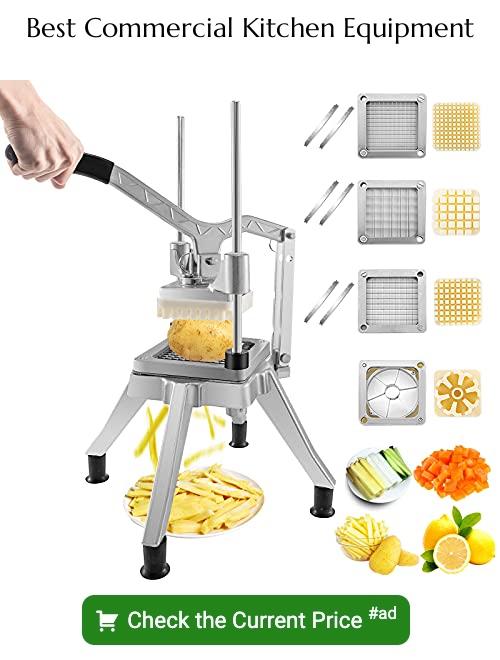Last updated on
Discover how to transform your property into a bustling culinary hub by constructing a commercial kitchen, in this detailed guide.
If you’ve ever dreamed of starting your own food business or simply want the convenience of having a commercial-grade kitchen in your own home, you may have wondered if it’s possible to build a commercial kitchen on your property. Well, wonder no more! In this article, we will explore the ins and outs of creating a commercial kitchen right at home.
We’ll discuss the necessary permits and regulations, equipment requirements, and even offer some tips for designing an efficient and functional space. So let’s dive in and discover how you can turn your culinary dreams into reality!
What's Inside
Understanding the Basics of a Commercial Kitchen
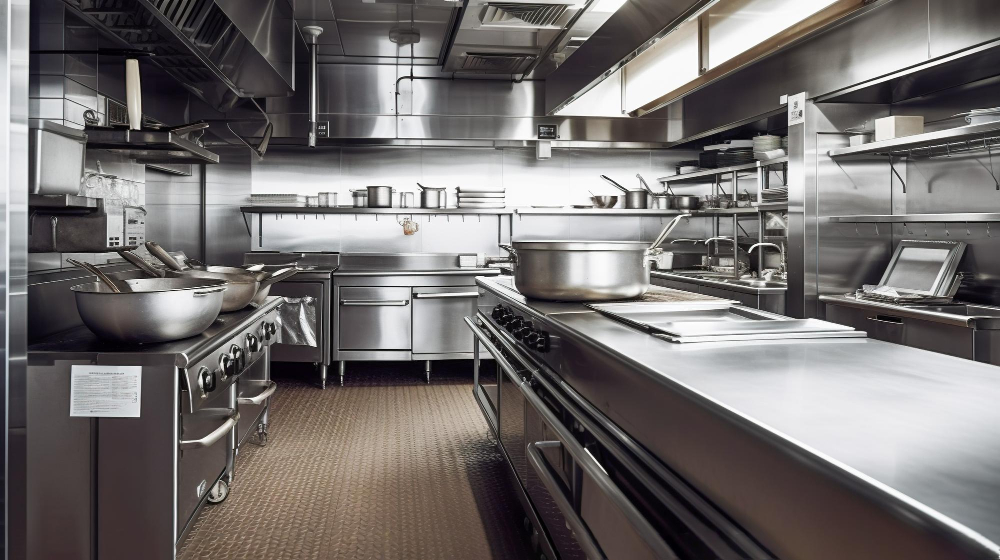
Before diving into the nitty-gritty details of building a commercial kitchen on your property, it’s important to understand the basics of what constitutes a commercial kitchen. Unlike a regular residential kitchen, which is primarily designed for personal use and occasional entertaining, a commercial kitchen is specifically tailored for high-volume food production and professional cooking.
In order to be classified as a commercial kitchen, certain criteria must be met. These include having specialized equipment that can handle heavy usage and meet industry standards for safety and sanitation.
There are specific regulations regarding zoning laws, permits, licenses, fire safety measures, ventilation systems,and waste management that need to be adhered to.
Understanding these fundamental aspects will help you navigate through the process more effectively as you embark on creating your own culinary haven at home.
What Makes Something A Commercial Kitchen?
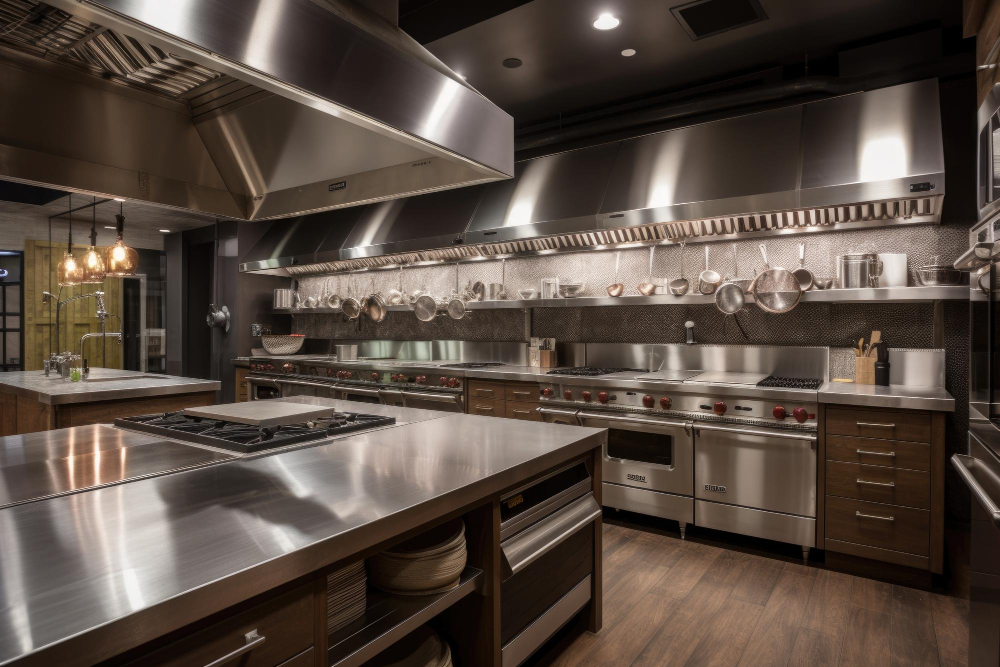
Unlike your typical residential kitchen, which is primarily designed for personal use and occasional entertaining, a commercial kitchen is specifically tailored for high-volume food production and professional cooking.
So what sets apart a regular home kitchen from its commercial counterpart? Several key factors come into play. Firstly, size matters.
A commercial kitchen typically requires more space than an average residential one due to the need for multiple workstations and specialized equipment.
Functionality plays an essential role in defining a true commercial-grade setup. Commercial kitchens are designed with efficiency in mind – every inch of space is carefully planned out to maximize productivity while ensuring smooth workflow during busy hours.
Furthermore, safety regulations are much stricter when it comes to operating within the realm of food businesses. From fire safety measures like proper ventilation systems and fire suppression equipment to compliance with health codes regarding sanitation practices – all these aspects contribute towards making something truly qualify as a legitimate commercial kitchen.
Assessing the Feasibility of a Commercial Kitchen On Your Property

While having your own culinary haven may sound like a dream come true, there are several factors you need to consider.
First and foremost, take stock of the available space on your property. Is there enough room to accommodate all the necessary equipment and meet regulatory requirements? Consider not only the physical dimensions but also any zoning restrictions that may apply in your area.
Next, evaluate whether constructing a commercial kitchen aligns with local regulations and permits. Research any specific laws or ordinances governing food businesses in residential areas.
It’s essential to ensure that you can legally operate a commercial kitchen from home without facing potential fines or legal issues down the line.
Think about how this venture will impact both yourself and those around you. Will noise levels increase significantly? Are there neighbors who might be affected by increased traffic or odors associated with running a professional-grade kitchen?
Lastly, carefully weigh financial considerations before proceeding further. Building and maintaining a commercial kitchen can be costly; therefore it is important to determine if this investment aligns with your budgetary constraints.
Factors to Consider Before Building a Commercial Kitchen On Your Property
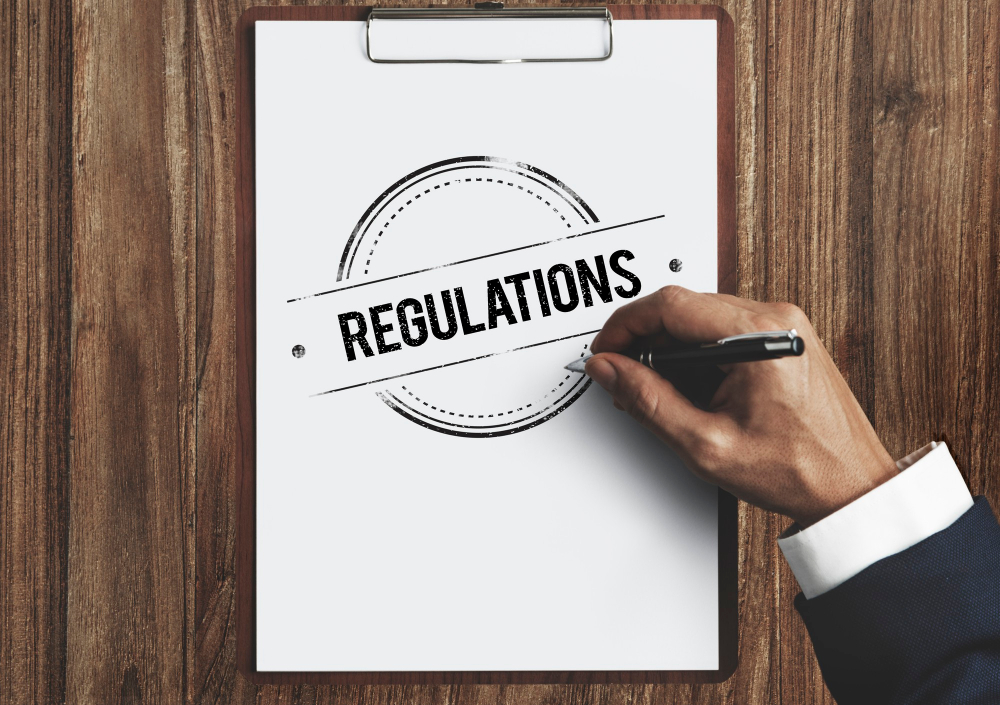
These considerations will help ensure that you make informed decisions and set yourself up for success in creating your culinary haven.
Firstly, it’s crucial to assess the demand and feasibility of having a commercial kitchen on your property. Are you planning to start a food business or simply want the convenience of an upgraded kitchen? Understanding your goals and evaluating the market demand for such services in your area is essential.
Next, take into account any local regulations or restrictions that may impact building a commercial kitchen on residential property. Zoning laws vary from place to place, so it’s vital to research what permits are required and if there are any limitations regarding noise levels, parking spaces, or hours of operation.
Another critical factor is space availability. Consider whether you have enough room for both the cooking area as well as storage facilities like walk-in refrigerators/freezers and dry storage areas.
Adequate space allocation ensures smooth operations without compromising safety standards.
Think about how constructing a commercial kitchen might affect other aspects of daily life at home – both practically and financially. Will it disrupt family routines? Can you handle potential increases in utility bills due to higher energy consumption?
Lastly but importantly: budgeting! Building a fully functional commercial-grade kitchen can be costly; therefore setting aside sufficient funds is crucial before embarking on this project. Take into account not only construction costs but also equipment purchases (including maintenance), licensing fees,and ongoing operational expenses such as staffing costs.
Evaluating the Space Required for a Commercial Kitchen

Assessing your available space will help you determine if it can accommodate all the necessary components of a functional and efficient commercial kitchen.
Consider factors such as square footage, layout, and existing infrastructure. Take into account not only the cooking area but also storage spaces for ingredients, utensils, and equipment.
Adequate workspace is crucial to ensure smooth operations in a busy kitchen environment.
Think about how many people will be working in the kitchen at any given time. Will there be multiple chefs or staff members? This will impact both floor space requirements and traffic flow within the area.
Remember that safety regulations often dictate minimum clearances around equipment like stoves or ovens to prevent accidents or fires. Be sure to factor these specifications into your evaluation process as well.
Understanding Commercial Kitchen Regulations

These regulations are in place to ensure food safety, maintain hygiene standards, and protect public health.
Commercial kitchen regulations can vary depending on your location and jurisdiction. It is essential to research and understand the specific rules and requirements set forth by local government agencies or health departments.
These regulations typically cover areas such as zoning laws, permits, licenses, fire safety measures, waste management systems, ventilation requirements, plumbing specifications for water supply and drainage systems.
To comply with these regulations effectively:
1. Consult Local Authorities: Reach out to your local government agencies or health departments responsible for overseeing commercial kitchens in your area.
They will provide you with detailed information about specific codes and guidelines that must be followed during construction.
2. Hire Professionals: Consider working closely with architects who specialize in designing commercial kitchens or hiring contractors experienced in constructing these types of facilities.
They will have knowledge of current building codes related to commercial kitchens which can help ensure compliance throughout the process.
3. Stay Updated: Keep yourself informed about any changes or updates made regarding regulatory requirements for operating a commercial kitchen within your locality as they may evolve over time.
Legal and Zoning Requirements for Commercial Kitchens

These regulations ensure that your kitchen meets all necessary health and safety standards, as well as any specific guidelines set by local authorities.
Before embarking on any construction or renovation work, it is essential to check with your local government or municipality regarding the zoning laws for operating a commercial kitchen from home. Zoning laws vary from one area to another and may have specific restrictions or permits required for running a food-related business.
In some cases, residential areas may not be zoned for commercial activities at all. However, certain jurisdictions offer special permits or exceptions known as “home occupation” permits that allow limited-scale businesses within residential zones.
It’s important to understand these regulations before investing time and money into building a commercial kitchen on your property.
There are often strict health department guidelines in place when it comes to operating a food establishment commercially. These guidelines typically cover aspects such as proper sanitation practices, waste management protocols, ventilation requirements for cooking equipment (such as hoods), plumbing specifications including grease traps installation if needed), fire safety measures like fire suppression systems (if applicable), among others.
To ensure compliance with these regulations while constructing your commercial kitchen space at home:
- Research: Familiarize yourself thoroughly with the relevant codes and ordinances governing food establishments in your area.
- Consult Professionals: Seek guidance from architects specializing in restaurant design or contractors experienced in building kitchens compliant with local regulations.
- Obtain Permits: Apply for any necessary permits related specifically to converting part of your residence into an operational business space.
- Inspections: Be prepared for inspections throughout the construction process by both zoning officials and health department representatives who will assess whether you meet their criteria before granting final approval.
- Ongoing Compliance: Once operational make sure you continue adhering strictlyto all regulations, including regular inspections and renewing permits as required.
By understanding and following the legal and zoning requirements for commercial kitchens, you can ensure that your project is not only successful but also compliant with local laws.
Navigating the Zoning Laws for Commercial Kitchens

Zoning regulations vary from one location to another, so it’s essential to familiarize yourself with the specific requirements in your area.
Zoning laws are put in place by local governments to regulate land use and ensure that different types of properties are appropriately situated within designated zones. These regulations help maintain a balance between residential areas, commercial spaces, and industrial zones.
When it comes to commercial kitchens, zoning laws typically dictate where these businesses can operate. Some areas may have specific zones dedicated solely for food-related businesses or require certain permits for operating a commercial kitchen out of a residential property.
To navigate these zoning laws successfully:
- Research Local Regulations: Start by researching your local government’s website or contacting relevant departments like planning or development services. They will provide information on which zone(s) allow for operating a commercial kitchen and any additional requirements you need to meet.
- Consult with Professionals: It is advisable to consult professionals such as architects or lawyers who specialize in zoning regulations before proceeding further with your plans.
- Obtain Necessary Permits: Once you understand the applicable rules and restrictions regarding running a business from home or converting an existing space into a commercial kitchen, make sure you obtain all necessary permits before starting construction.
- By understanding and complying with these zoning laws upfront, you can avoid potential legal issues down the line while ensuring that your dream of having an at-home culinary haven becomes reality without any hiccups along the way
The Process of Obtaining a Valid Business License

This crucial step ensures that you are operating legally and in compliance with local regulations.
The specific requirements for obtaining a business license can vary depending on your location, so it’s essential to research and understand the rules and procedures in your area. Typically, this process involves several steps:
1. Research: Begin by researching the licensing requirements for operating a commercial kitchen in your city or county.
Check with local government agencies or visit their websites to gather information about necessary permits, fees, inspections, and any additional documentation required.
2. Application Submission: Once you’ve gathered all the necessary information and documents (such as proof of ownership/lease agreement), submit an application for a business license at the appropriate government office responsible for issuing licenses.
3. Inspections: In many cases, before granting approval for a business license related to food service operations like commercial kitchens, health department officials will conduct inspections to ensure compliance with safety standards such as proper sanitation practices.
4. Compliance Adjustments: If any issues are identified during inspection(s), make sure to address them promptly according to guidelines provided by health department officials or other relevant authorities overseeing licensing processes.
- Fee Payment: Pay any applicable fees associated with obtaining or renewing your business license promptly within specified deadlines outlined by local regulations.
- Final Approval & Displaying License:
- After successfully completing all necessary steps including submitting required documents,
- passing inspections if applicable,
- and paying requisite fees,
- you will receive final approval
- for acquiring
- your valid
- business
- license.
- Make sure
- to display this prominently within
- your establishment once received;
- it serves as evidence that you’re authorized
By following these steps diligently throughout each stage of acquiring licensure,you’ll be well-prepared when navigating through the process of obtaining a valid business license for your commercial kitchen.
Fire Safety Measures in a Commercial Kitchen

As you embark on this exciting journey, it’s crucial to prioritize the implementation of effective fire safety measures. Not only will this protect your investment and comply with regulations, but it will also provide peace of mind for you and your staff.
To begin with, installing an automatic fire suppression system is essential. This specialized system can quickly detect and suppress fires before they have a chance to spread or cause significant damage.
It typically includes heat sensors that trigger the release of firefighting agents such as foam or gas when temperatures rise above safe levels.
Equipping your commercial kitchen with proper ventilation systems plays a vital role in preventing fires. Adequate ventilation helps remove smoke, grease particles, and other potentially flammable substances from the air while maintaining optimal airflow within the space.
Regular maintenance checks are equally important for keeping potential fire hazards at bay. Ensure that all electrical equipment is inspected regularly by certified professionals to identify any faulty wiring or malfunctioning components that could pose risks.
Furthermore, training employees on proper handling techniques for flammable materials like oils and cleaning chemicals should be part of every comprehensive fire safety plan in a commercial kitchen setting. Educating staff members about emergency procedures such as evacuation routes and how to operate firefighting equipment can make all the difference during critical situations.
Ensuring Compliance With Food Safety Practices

After all, maintaining a high standard of cleanliness and hygiene is not only essential for the health of your customers but also for the success of your business.
To guarantee compliance with food safety practices, start by implementing proper sanitation procedures. This includes regular cleaning and sanitizing of all surfaces where food is prepared or stored.
Make sure to use appropriate cleaning agents that are safe for use in a commercial kitchen environment.
Establish protocols for handling raw ingredients separately from cooked or ready-to-eat foods to prevent cross-contamination. This means using separate cutting boards, utensils, and storage containers for different types of foods.
Proper temperature control is another critical aspect when it comes to ensuring food safety. Invest in reliable thermometers to monitor both hot and cold temperatures accurately within refrigerators/freezers as well as during cooking processes.
Regularly check these devices’ accuracy through calibration tests.
Determining the Right Commercial Kitchen Layout
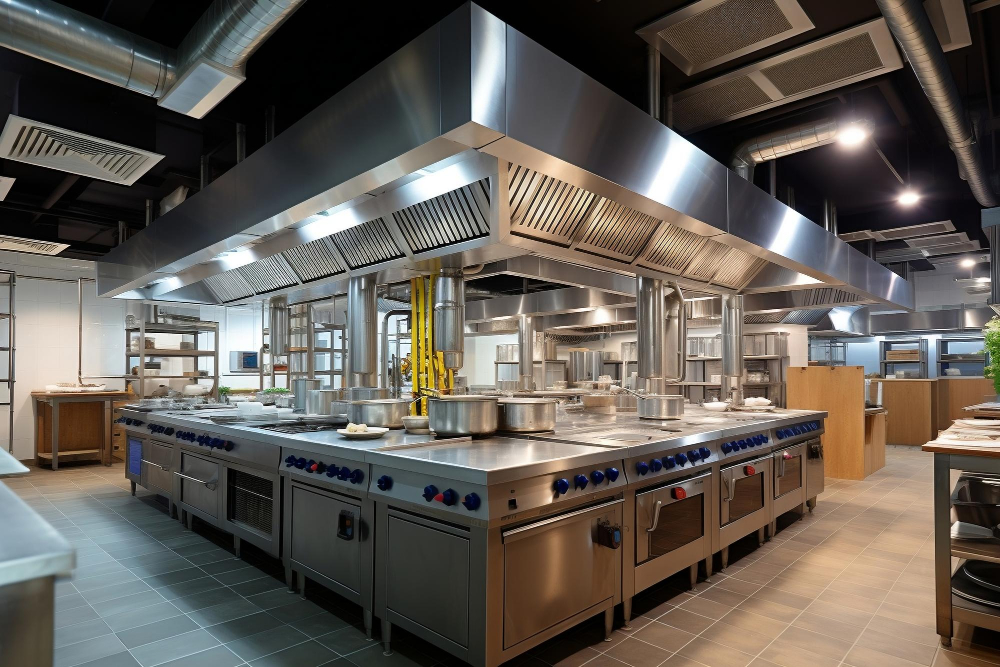
The layout of a commercial kitchen plays a crucial role in its efficiency and functionality, allowing you to maximize productivity while ensuring smooth operations.
Consider factors such as workflow, safety regulations, and space utilization when designing your commercial kitchen layout. A well-designed workspace will enhance productivity by minimizing unnecessary movement between different stations.
Start by identifying the primary work areas in your kitchen: food preparation area(s), cooking area(s), storage area(s), dishwashing station, and any additional specialized zones based on your specific needs (e.g., baking or pastry section). Each of these areas should be strategically placed to create an efficient flow from one task to another.
The classic “kitchen triangle” concept is often applied in residential kitchens but can also be adapted for commercial settings. This principle suggests that three key elements – refrigerator/storage unit, sink/washing station, and cooking surface – should form an imaginary triangle shape with easy access between them.
Adapting this concept can help streamline tasks within each work zone while maintaining optimal proximity between essential components.
Consider incorporating ample counter space throughout the kitchen where food prep activities take place. Adequate countertop surfaces allow multiple chefs or staff members to work simultaneously without feeling cramped or restricted.
Don’t forget about safety considerations when planning out your layout either! Ensure there are clear pathways free from obstructions so that employees can move around easily during busy periods without risking accidents or collisions with equipment or other staff members.
The Essential Equipment for a Commercial Kitchen
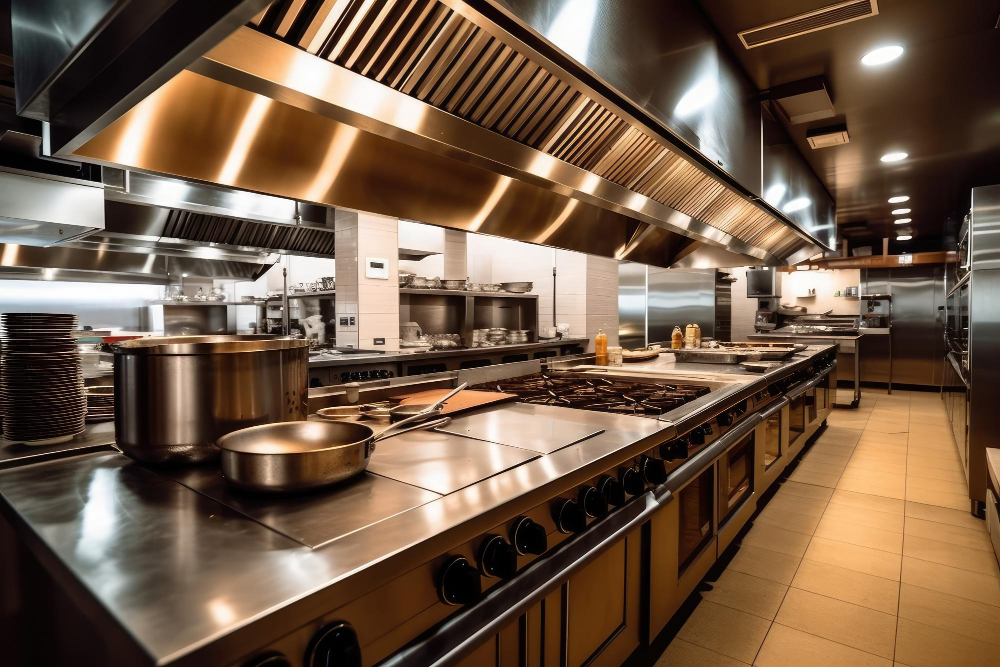
A well-equipped commercial kitchen is vital for efficient operations and ensuring that you can meet all your cooking needs. The right equipment will not only enhance productivity but also contribute to maintaining high standards of food quality and safety.
When outfitting your commercial kitchen, there are several key pieces of equipment that should be at the top of your list. These include:
1. Cooking Range: A reliable cooking range with multiple burners or cooktops is essential for preparing various dishes simultaneously.
Look for durable materials, easy-to-clean surfaces, precise temperature control features, and sufficient burner power.
2. Commercial Oven: Whether you’re baking pastries or roasting meats, a sturdy commercial oven is indispensable in any professional kitchen setting.
Consider factors such as size (depending on anticipated production volume), energy efficiency ratings, convection capabilities if desired, ease-of-use controls,and cleaning options when choosing an oven suitable for your needs.
- Refrigeration Units: Proper storage plays a critical role in maintaining food freshness while adhering to health regulations.A combination refrigerator-freezer unit with ample capacity will allow you to store perishable ingredients safely while keeping frozen items readily available.Consider investing in separate units if space allows,to ensure optimal temperature control between refrigerated goodsand frozen products.
- Preparation Surfaces:Adequate counter spaceis crucialfor prepping ingredients,chopping vegetables,and assembling dishes.Choose stainless steel countertopsas theyare durable,easyto clean,and resistantto stainsand bacteria growth.Additionally,includeworktablesor cutting boardsfor specific tasks,such as meat preparationor pastry rolling,to maintain hygiene standardswhile optimizing workflow efficiency.
- Commercial Dishwasher:A dependable dishwasher designed specifically forgreater capacity,cleaning power,and durabilityis a must-have for any commercial kitchen. Look for models that can handle high-volume usage, offer efficient water and energy consumption, and have adjustable wash cycles to accommodate different types of cookware.
Remember that the specific equipment you choose will depend on your menu offerings, anticipated production volume, available space,and budget constraints. Prioritize quality and functionality when making these important decisions to ensure smooth operations in your commercial kitchen.
How to Choose Commercial Grade Appliances

Commercial grade appliances are designed to withstand heavy use and meet specific industry standards, making them essential for any professional kitchen.
When selecting commercial grade appliances for your home-based culinary venture, there are several factors to consider. First and foremost is functionality.
Think about what types of dishes you plan on preparing and what equipment will be required to execute those recipes efficiently.
For example, if baking is a significant part of your menu, investing in a high-quality convection oven with multiple racks may be crucial. On the other hand, if you’re planning on offering an extensive range of grilled or fried items like burgers or fries at your eatery or food truck business from home; then opting for durable grills and deep fryers would make more sense.
Another important consideration when choosing commercial-grade appliances is energy efficiency. Look for models that are Energy Star certified as they can help reduce utility costs in the long run while being environmentally friendly.
Pay attention to durability and ease-of-maintenance features offered by different brands before making a final decision. Appliances that require frequent repairs can quickly become costly headaches down the line.
Ventilation Needs for a Commercial Kitchen
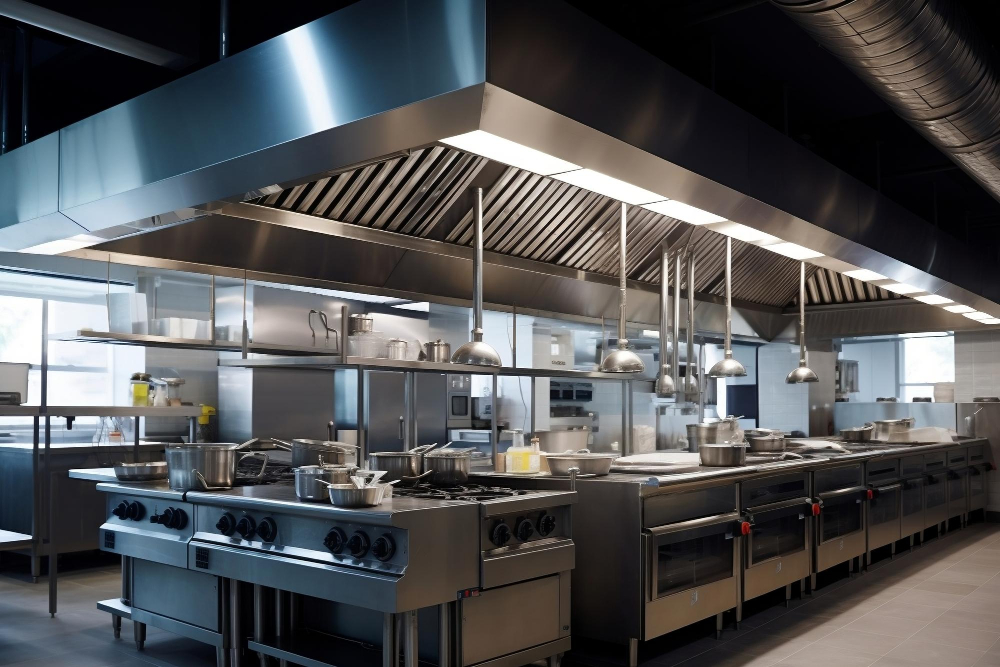
As the sizzling sounds of pans and the tantalizing aromas of food fill the air, it’s essential to have proper ventilation in place to maintain a comfortable and safe environment.
Commercial kitchens generate an abundance of heat, smoke, steam, and odors that need to be effectively removed from the space. Without adequate ventilation systems in place, these byproducts can linger in the air, leading to poor indoor air quality and potential health hazards for both you as the chef and any staff members working alongside you.
To ensure optimal ventilation within your commercial kitchen setup, there are several key components you should incorporate into your design. These include:
1. Exhaust Hoods: Installing high-quality exhaust hoods above cooking equipment is vital for capturing grease-laden vapors at their source.
These hoods help remove heat, smoke particles, and other airborne contaminants efficiently.
2. Ventilation Ducts: Once captured by exhaust hoods or canopy systems above cooking stations, the contaminated air needs proper ductwork for extraction outside or through filtration systems.
Ducts should be designed with smooth surfaces that minimize airflow resistance while preventing grease buildup.
- Make-Up Air Systems: To replace exhausted air with fresh outdoor air without creating negative pressure within your kitchen space (which could hinder performance), make-up
- air units are necessary additions.
- Ventilation Fans:
- High-powered fans play a crucial role in expelling stale indoor air while ensuring consistent airflow throughout all areas of your commercial kitchen.
- By incorporating these elements into your overall design plan,
- you’ll create an efficient system that removes unwanted pollutants from
- your workspace effectively—keeping both yourself and those around you healthy
- and comfortable during long hours spent preparing culinary delights.
Water Supply and Plumbing Specifications

After all, a well-functioning kitchen relies heavily on access to clean water for cooking, cleaning, and sanitation purposes.
Before embarking on the construction of your commercial kitchen, it’s important to assess the existing plumbing infrastructure in your property. You may need to consult with a professional plumber or contractor who can evaluate whether any upgrades or modifications are necessary.
In terms of water supply requirements for a commercial kitchen, you’ll typically need both hot and cold running water at various stations such as sinks, dishwashing areas, food preparation zones, and even specialized equipment like steamers or coffee machines. Adequate pressure is also essential for efficient operation.
Waste Management Systems for Commercial Kitchens

A well-designed waste management system is essential not only for maintaining a clean and hygienic environment but also for complying with health regulations.
In a bustling commercial kitchen, there can be various types of waste generated on a daily basis – from food scraps to packaging materials. To effectively manage this waste, you’ll need to implement proper disposal methods that prioritize both efficiency and sustainability.
One common approach is implementing separate bins or containers designated specifically for different types of waste such as organic matter (food scraps), recyclables (plastic bottles or cardboard), general trash (non-recyclable items), and potentially hazardous materials like cleaning chemicals. This segregation allows easy sorting at the source itself while minimizing cross-contamination risks.
Consider investing in durable trash cans or bins that are easy to clean and have secure lids to prevent odors from spreading throughout your kitchen space. Incorporating recycling stations with clearly labeled compartments will encourage staff members to dispose of recyclable items correctly.
To further enhance sustainability efforts in your commercial kitchen’s waste management system, explore options like composting organic matter instead of sending it all straight into landfills. Composting not only reduces environmental impact but can also provide nutrient-rich soil amendments if you have gardening plans on-site!
Remember that regular maintenance is key when it comes to managing wastes efficiently in a busy environment like a commercial kitchen. Schedule routine cleaning sessions where staff members empty bins regularly throughout their shifts rather than letting them overflow before disposal takes place at day-end.
Detailed Cost Breakdown of Building a Commercial Kitchen

Understanding the detailed cost breakdown is crucial in planning and budgeting for your project.
Building a commercial kitchen involves various expenses that need to be taken into account. These costs can include:
1. Construction: This encompasses everything from renovating an existing space or constructing a new one, including materials, labor costs, permits, and architectural fees.
2. Equipment: Commercial-grade appliances such as ovens, refrigerators, dishwashers are essential components of any professional kitchen setup.
The cost will depend on factors like brand reputation and specific features required for your business needs.
3. Plumbing and Electrical Work: Installing proper plumbing systems for sinks, grease traps (if applicable), gas lines (if needed), as well as electrical wiring upgrades to handle heavy-duty equipment are additional expenses that should be considered.
4. Ventilation System: A robust ventilation system is vital in maintaining air quality by removing heat, smoke odors from cooking processes effectively; this includes exhaust hoods with fire suppression systems along with ductwork installation.
- Permits & Licensing Fees: Obtaining necessary permits related to construction work or operating licenses may involve certain fees depending on local regulations which vary by jurisdiction.
- Miscellaneous Costs : Other miscellaneous expenses might include interior design elements like flooring choices suitable for commercial kitchens’ high traffic areas or specialized lighting fixtures designed specifically for food preparation spaces.
It’s important not only to consider these individual costs but also factor in potential unexpected expenditures that may arise during construction or due diligence process.
Hiring Architects and Contractors for Commercial Kitchens

Hiring architects and contractors who specialize in commercial kitchens is crucial to ensure that your project is executed smoothly and meets all necessary codes.
Architects play a vital role in designing an efficient layout for your kitchen. They will consider factors such as workflow optimization, proper placement of equipment, ventilation systems, plumbing needs, and compliance with building codes.
Their expertise will help create a functional space that maximizes productivity while adhering to safety standards.
When selecting an architect or contractor for your commercial kitchen project, be sure to look for those with experience specifically in this field. Ask about their previous projects related to food establishments or inquire if they have any certifications relevant to restaurant design.
Contractors are responsible for turning architectural plans into reality by overseeing construction work on-site. They coordinate various tradespeople such as electricians and plumbers while ensuring that everything is built according to specifications within budgetary constraints.
To find reputable architects and contractors specializing in commercial kitchens:
- Seek recommendations from other business owners who have successfully built their own kitchens.
- Research online directories or platforms dedicated specifically to connecting clients with professionals experienced in restaurant construction.
- Consult local trade associations or organizations related directly to the foodservice industry; they often maintain lists of recommended service providers.
Final Inspection and Licensing Requirements

Before you can officially open for business, there are a few important steps left to take. One of these crucial steps is the final inspection and obtaining the required licenses.
The final inspection ensures that your commercial kitchen meets all safety standards and regulations set by local authorities. An inspector will visit your property to assess various aspects such as fire safety measures, ventilation systems, plumbing connections, waste management systems, and overall compliance with food safety practices.
During this inspection process, it’s essential to have all documentation readily available for review. This includes permits obtained during construction or renovation phases as well as any certificates of compliance from licensed professionals involved in building or installing specific components of your kitchen.
Once you pass the final inspection successfully (congratulations!), it’s time to move on to licensing requirements. Depending on where you live and operate your business from; different licenses may be needed at both state/provincial levels as well as local municipal levels.
These licenses typically include health department permits certifying that you meet hygiene standards when handling food products; liquor license if applicable (for establishments serving alcohol); general business license indicating that you are legally allowed to operate a commercial establishment within specified parameters; zoning clearance confirming that your property complies with land-use regulations for operating a commercial enterprise at its location.
It’s crucial not only to understand which licenses apply specifically but also their renewal periods so they can be kept up-to-date throughout operation continually. By ensuring proper completion of inspections along with obtaining relevant licensing requirements promptly after construction concludes – You’ll soon find yourself readying those pots & pans while eagerly awaiting customers’ arrival!
Remember: Compliance with inspections & acquiring appropriate licensure demonstrates professionalism while safeguarding public health interests – So don’t overlook these vital last steps!
FAQ
Can you have a commercial kitchen in your home in California?
Yes, you can have a commercial kitchen in your home in California, but it requires obtaining a permit from the county health department.
Can you have a commercial kitchen in your home in Colorado?
Yes, you can have a commercial kitchen in your home in Colorado, but if you sell food beyond what is permitted by the Cottage Foods Act, a Colorado Sales Tax License and potentially additional licenses are required.
Can you have a commercial kitchen in your home in Georgia?
No, you cannot convert your home kitchen into a commercial kitchen in Georgia, but you can use it for operations specific to your primary residential unit under the Georgia cottage food law.
How do I get a commercial kitchen license in California?
To get a commercial kitchen license in California, you must obtain either a Food Handler Card or a Certified Food Protection Manager certificate by completing a safety-training course and passing an exam.
What are the specific requirements to build a commercial kitchen in your home in Texas?
To build a commercial kitchen in your home in Texas, some specific requirements include: adhering to local zoning laws and health department regulations, installing correct ventilation, having proper food storage, obtaining necessary permits, and ensuring the kitchen is separate from living areas.
How to comply with health and safety regulations when setting up a commercial kitchen in Florida?
To comply with health and safety regulations when setting up a commercial kitchen in Florida, one needs to follow all guidelines as per the Florida Department of Health, including adequate space and sanitation, proper food handling, training for staff, and routine inspections.
Is it legal to operate a commercial kitchen from a residential area in New York?
Operating a commercial kitchen from a residential area in New York may be restricted and subject to local zoning laws and health department regulations.
